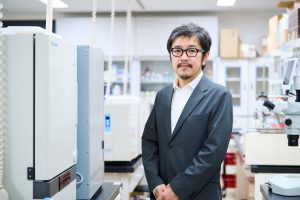Findings suggest lactic acid may regulate the fermentation properties of yeast in sake brewing
2023.03.17
The behavior of yeast and lactic acid were examined and compared between traditional kimoto brewing and modern sake brewing and the findings published in an international journal
A research group led by Professor and Center Director Koichi Tanabe and Professor and Center Deputy Director Jun Shima published an article in the international journal Yeast on the effects of lactic acid addition on the fermentation abilities of yeast in sake brewing.
[Presented Paper]
Title: Emergence of [GAR+] cells in yeast from sake brewing affects the fermentation properties
Authors: Koichi Tanabe1,3, Natsumi Maeda1, Honka Okumura2, and Jun Shima2,3
Affiliations: 1 Department of Food Science and Human Nutrition, Faculty of Agriculture, 2 Department of Life Sciences, Faculty of Agriculture, 3 Microbial Resource Center for Fermentation and Brewing
Publishing Journal: Yeast (Wiley)
URL:https://doi.org/10.1002/yea.3844
• Published online February 8, 2023
The findings suggest lactic acid is not simply a bacteriostatic agent, but may regulate the fermentation properties of yeast in the sake brewing process.


Below are presented some comments from Center Director Tanabe on why this research was undertaken, the goal of the research, and future prospects.
Q1. What was the reason for investigating this topic?
“Modern sake brewing adds lactic acid to the fermentation broth to suppress the growth of non-useful organisms. Recent research has shown the emergence of yeast cells with altered fermentation abilities, called [GAR+] cells, among the other yeast cells and that lactic acid causes a marked increase in these [GAR+] cells. I wanted this research to answer the question of whether lactic acid addition could affect the fermentation abilities of yeast in sake brewing.”
Q2. This research looks at kimoto, a traditional sake brewing method. Did sake brewing companies help you with this research?
“I conducted the research with samples provided by two sake brewing companies that work actively with kimoto brewing methods in Shiga Prefecture. Since brewing by the kimoto method is a lengthy process, I thought it would allow the emergence of [GAR+] cells with different frequencies over time. We isolated a strain of [GAR+] cells in the kimoto brewing environment that emerged with much a higher frequency than normal sake brewing yeast and intend to continue studying this strain.”
Q3. It is often said that yeast and lactic acid work in tandem in the starter mash used to brew sake. Could you explain the relationship between these two ingredients?
“Modern sake brewing adds lactic acid to the fermentation broth to suppress the growth of non-useful organisms. In traditional brewing by the kimoto method, lactic acid is not added but is produced by lactic acid bacteria in the starter mash. It is not unreasonable to say that sake production has always grown yeast in the presence of lactic acid.
The yeast used to brew sake in Japan may respond to lactic acid through unique mechanisms that set it apart from the yeast used to produce other fermented foods (wine, beer, bread, etc.).”
Q4. How do you think the findings of this research will affect the development and use of fermentation and brewing technology, and wider society and the environment?
“As I mentioned in my response to Q3, the relationship between lactic acid and yeast is essential to sake brewing. This paper suggests lactic acid is not simply a bacteriostatic agent, but may regulate the fermentation properties of yeast. Strict control over lactic acid concentration may allow the development of new sake production methods.”
Q5. Do you have any plans to develop this research any further?
“I would like to verify whether the effect of [GAR+] cells on fermentation properties demonstrated in this paper can be observed during real-world sake production. I would also like to investigate to what extent the fermentation activity-regulating abilities of lactic acid are evident in yeast used in other fermentation and brewing processes and yeast in the natural world.”
Established in 2021 to support the fermentation and brewing industry of Shiga Prefecture, the Microbial Resource Center for Fermentation and Brewing collects microorganisms useful for fermentation and brewing, builds databases of these microorganisms, and undertakes research aimed at developing applications for these microorganisms.